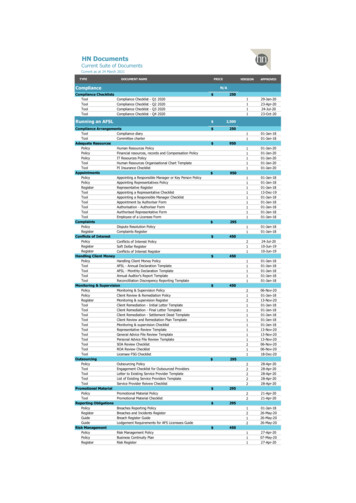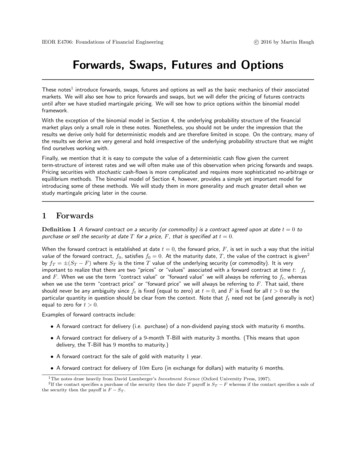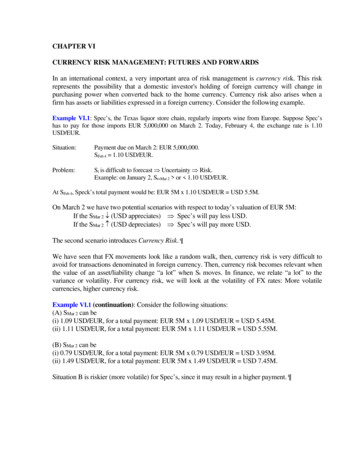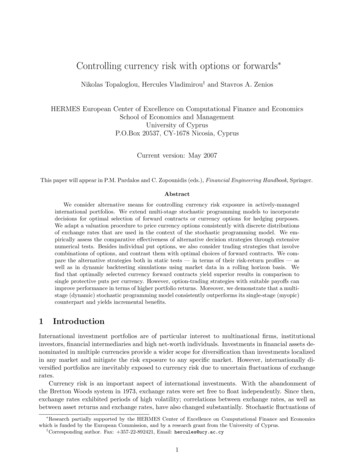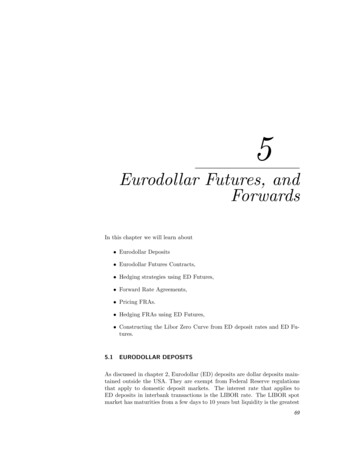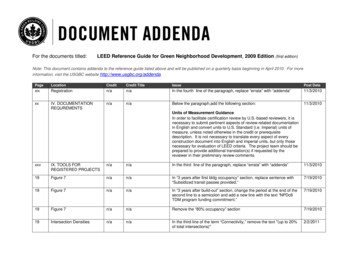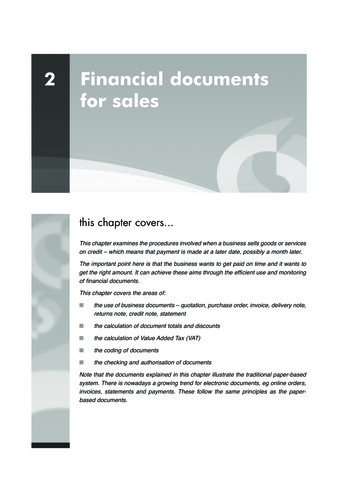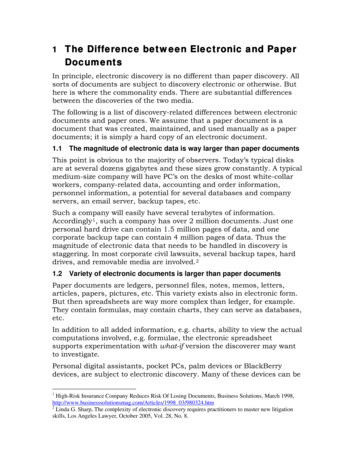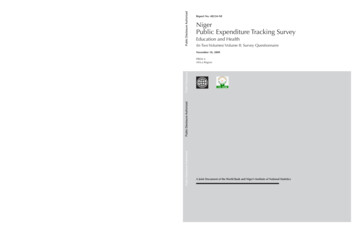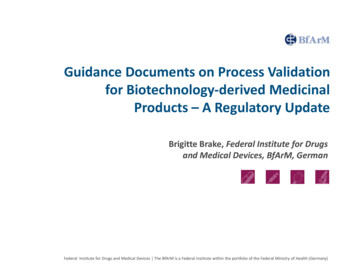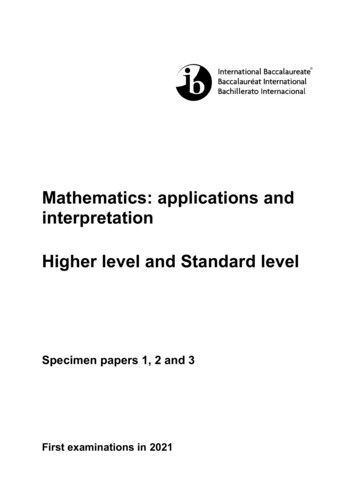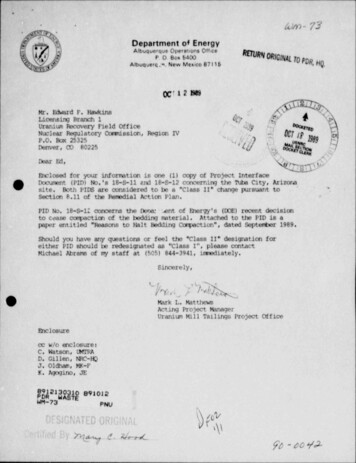
Transcription
e"'-(g. 73-.9! pp tG'S,wi' 2Department of EnergyAlbuquerque Operations Off ace--'P.O. Box 5403Albuquergem. New Mexico 87115 REIUN40RIGINAl. ToIOOCr 121989./Mr. Edward F. HawkinsLicensing Branch 1Uranium Recovery Field OfficeNuclear Regulatory Conmission, Region IVP.O. Box 2532588-8/q,'V,p,''4.'Denver, 00 80225\tj#6tear Ed,8s''e%gfj,h(Og[jp18883,' ooc [g,. ,pEnclosed for your information is one (1) copy of Project Interface,'lVDocument (PID) No.'s 18-S-11 and 18-S-12 concerning the Tuba City, Arizonasite. Both PIDS are considered to be a " Class II" change pursuant toSection 8.11 of the Remedial Action Plan.','-PID No.18-S-1; concerns the Dooadent of Enetw's (DOE) recent decisionto cease conpaction of the bedding material. Attached to the PID is apaper entitled " Reasons to Halt Bedding Conpaction", dated September 1989.Should you have any questions or feel the " Class II" designation foreither PID should be redesignated as " Class I", please contactMichael Abrams of my staff at (505) 844-3941, imediately.Sincerely,s3 Lt.-,'*,.O- - -sMark L. MatthewsActing Project ManagerI' ) -LoUranium Mill Tailings Project officeEnclosureoc w/o enclosure:C. Watson, UMTRAD. Gillen, NRC-lOJ. Oldham, MK-FK. Agogino, JE8912130310 891012PDRWM-73 WASTEPNVDESlGNATED ORIGINMwrtined By %MM/0Drgggb - oo 42.-
---- - - -.O.-O- .''MORRISONUMTRA PROJECT OFFICEPROJECT INTERFACE DOCUMENT*KNUDSENI'5iteDateTuba Cityd!BoSYon'Na Francisco'19 sent 19891R-s 11*18" *",,*g, g."" * ' '#**"'Nk [UU442-7586'Vic Pro No.Site No.PID No. dcentract No:SubjectTuba City, Surveillance and Maintenance - Aerial Photography CoveragePROBLEM:'O ChangeO C1ertricationDescription of Problem and Recosseended SolutionIt is necessary to increase the project area covered by vertical photographs to include monitorwells 901 and 910 north of the highway 160, and the area to the southeast between the site boundaryand Moenkopi Wash, to conform with the draft S&M Plan.SOLUTION: Revise Spec. No. 01056 - Aerial Photography and Mapping, paragraph 1.3.A, and Drawing No.TUB-PS-10-0835, to indicate the increased area of photographic tionO Disapproveo D APProvea as noteopApprovedO yesCriteria Changer(If Yes. 00E approval required),,,,,,(j gg,j jjg, g,,g 3,ggg,,(- % /- 7 fhhMS ald)RAC Project controlG No,,Class II,,RAC Construction Engineer Mt/ N b ,,'Revfewed for QualityC',b 4/pfhFY* O /dRequirestentsDate51gnatureDistributionRAC site Mgr.LocationName[((/M/eRAC Constr. Engr. Mgr.cost /Itse Est./I 8mrd/O AttachedO Not RequiredM ( 'c d,-DOE Proj Engr. /77 ///hnr) TAC site Mgr.LocationNameSiRAC Qual. Mgr.Other/ /.W-//r/f r-)E /4.,3f 5/!D Det Approvatfr- /' #*. Y /sY1t ARAC site Que1. Enge. {L)Ct/C [ fl et/-/d;RAC HSSE Mgr.[," ,jge.m-og 7-9.n.*t i cin a ). . .-. . - - - - - -- . . ,. - .
.-O-.MORRISON'(- ./ .- .g.y-UMTRA PROJECT OFFICEPROJECT INTERFACE DOCUMENT'*KNUDSENU**" 18-S-1225 Sept. 1989Tuba CityOriginator and Location415/ 44'/ 75R6Dorok M Rnitnn. 9FOSubject" * ' " **''''* 18References:Answer By:OrganfrationPhoney-i;ubcontract:MVF9Subcontract No:,Tuba City - Delete Bedding Compaction from SpecificationbChangeO Ciarifscat1onDescription of Problem and Recossended Solution-,Problem:It has been detemined that compaction of.the bedding may be detrimental to the erosionbarrier performance.Solution:Delete all references to compaction from specification 02278, Rev.3 - Erosion Protection,Paragraphs 3.1, 3.1.B, 3.1.F and 4.2. Delete Paragraph 3.1.C and renumber Paragrphs 3.1.0 thru F.,!.IOriginatorSignatureDispositionRAC Project Control0 NoO vesCriteria Change?(!f Yes. DOE approval required)Class IIp''h'y'Reviewed for QualityRAC Site Mgr.NameLocationRACConstr. Engr.Mjr.DOE Proj Engr. /77 /// mr M1AC 51te Mgr.RAC Qual. Mgr.Other)C BiiddRAC Sf te Qual. Engr. n) h/r s'RAC HSSE Mgr.E }rY/fCf[2 74-'{1/ [p {h g O /,/2dfL3[4,[8?b4/27/S4DateSignatureLocationName/[ [L,([/)pt"T',# M M tsdIV -RAC Construction EngineerRequirementsDistributtonDate,,RAC Site Manage [ f 8 M M WOJ ArO D8saPProved O dpproveo as Noteo% Approved7-27 69y ." "Cost /Ilme ist.[. [cor ct//O AttachedO Not Reovired/d OCSE Fe/o2/sk-{{Mm, iYg/ty)[j,1a c0E Appro,,1*'Q,'c, aM K-o67-t"?( 10/3 4). . .7
n.,-',,.7,,,- .,,*.jE',-J-.UMTRA PROJECTTUBA CITY,-ARIZONA-DREASONS TO HALTBEDDING COMPACTIONV.,,,.i?!I' r.\( . .::\/ji'!' i( 4! SEPTEMBER 1989 t .ei.'! i.bi
'.'.TUBA CITY DISPOSAL CELLREASONS TO HALT BEDDING COMPACTION*CURRENT SITUATIONThe technicalcurrently callspecifications for the Tuba City remedial action constructionfor -compaction of the bedding layer by four passes of asmooth drum roller. This compaction should be halted and the specificationschanged. This document records the basis for that reconnendation.About ten percent of the bedding at the Tuba City pile has been placed toVisually, the compaction produced a very dense layer with a verydate.,The dense, smooth bedding will not function as a suitablesmooth surface.or efficient bedding layer, for the reasons described below.AU-TECHNICAL BACKGROUND3As a matter of terminology, note that the bedding layer is often referred to 'Regardless ofas the filter layer, the filter blanket, or the drain layer.the precise term used, the layer of importance to this recommendation is thesix-inch layer of silts, sands, and gravels placed on top of the silts andclays of the radon barrier and beneath the cobbles and boulders of theerosion barrier or riprap layer.The NRC report " Development of Riprap Design Criteria by Riprap Testing inNUREG/CR-4651 prepared by S.R. Abt et al. on page 76Flumes: Phase 1"states the following:The 2-inch median stone diameter riprap was tested in the outdoorNVfacility on a 20 percent slope with and without a 6-inch thick filterThe average unit discharge at failure of the 2-inch riprapbl anket.without a filter was 0.30 cfs/ft.However, when a 6-inch filterblanket was placed beneath the 6-inch layer of 2-inch riprap, the unitdischarge at failure increased to 0.50 cfs/ft.Apparently,thepresence of the filter increased the resistance to riprap movement bynearly 67 percent. The same riprap and method of placement was used inall tests."To state the observation another way: an erosion barrier not properly beddedis likely to be 40 percent less stable than an erosion barrier that isproperly bedded.The riprap placed on the compacted and smooth, unyielding surface of theTuba City disposal cell bedding will most likely perform as the riprap inthe NRC tests placed without a bedding layer. In short, if we compact thebedding at Tuba City, the riprap will be at least 40 percent less stablethan if we do not compact the bedding.
Tp:.y a; ynsc un .'.I .- . ?4 ''.-. .--?pfor the difference in theless energy 11here: is: -a very . simple technical: explanationperformance of riprap placed with:and without adequate bedding, smooth surface tha.is. required to move : an object down atIf there is no bedding or the bedding is compacted so that it issurfaceunyielding and smooth less energy is required to fail the riprap layer than.is. required if:the bedding' surface'is rough or the riprap tends to bed intoThe tests reported by: the NRC merely confirm this materials. . , . j*',the- filter:."logical. deduct' ion.in charge of the workSteven Abt. of- Colorado State ' University,'wasinaddition, he hasLdescribed in the NRC : report referenced above, JDr.many-other studies on the erosionalstability of riprap and coverHe is proUMTRA Project.systems 'such' as ,those -used. on theHe concurs with the'foremost authority, on the subject of riprap stability.that :we should not be compacting the bedding layer at Tuba Cityconclusionssupervised!-or other!UMTRA Project sites,tSsQE.',CONCLUSIONpreponderance of logic, test data, andHence,there'is;annoverwhelmingbackupthe recommendation to stop compactioexpert opinion toCity'' bedding layer -and to desist from this practice-at other UMTRA Project p,. sites. ' .\, 1uo.i!.E- -j -
G Albuquerque Operations Off ace REIUN40RIGINAl. ToION, HQ,--S i' 2 P.O. Box 5403 ' ',w Albuquergem. New Mexico 87115 OCr 121989. Mr. Edward F. Hawkins / \ s' 8 'e Uranium Recovery Field Office-8/ ,'V,p,h(Og[jp1888 Licensing Branch 1 8 ', q 8%g Nuclear Regulatory Conmission, Region IV 4 '.-3, fj P.O. Box 25
